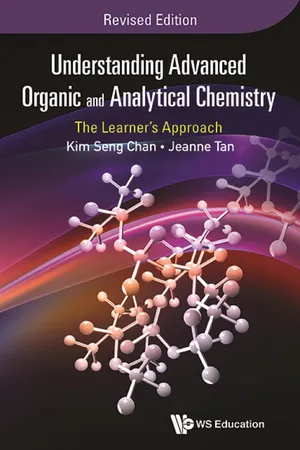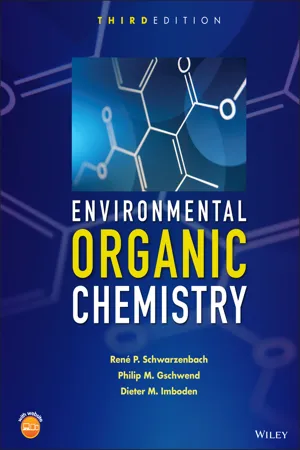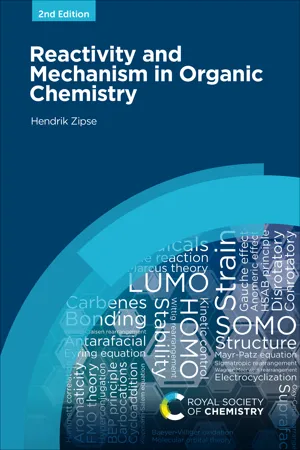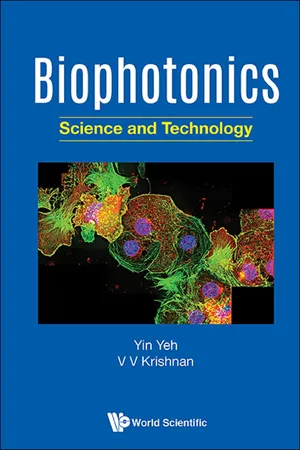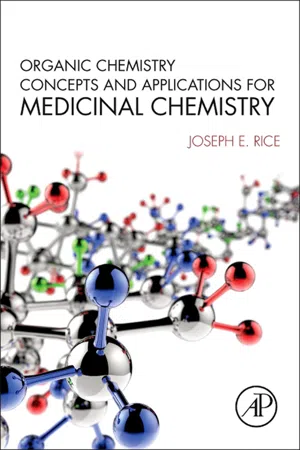Structure of Organic Molecules
The structure of organic molecules refers to the arrangement of atoms within a molecule. Organic molecules are composed of carbon atoms bonded to other atoms such as hydrogen, oxygen, nitrogen, and sulfur. The arrangement of these atoms and the types of bonds between them determine the physical and chemical properties of the molecule.
7 Key excerpts on "Structure of Organic Molecules"
- eBook - ePub
Understanding Advanced Organic and Analytical Chemistry
The Learner's ApproachRevised Edition
- Kim Seng Chan, Jeanne Tan;;;(Authors)
- 2016(Publication Date)
- WS EDUCATION(Publisher)
CHAPTER 1
Structure and Bonding
1.1 Introduction
Hearing the words “organic chemistry” may strike fear in some students, but this should not be the case at all. You may have come across complex-looking structures, alien-looking mechanisms and reactions. Exam questions about such may confuse you and heighten anxiety, but the answers to these questions need not be highly sophisticated, as these usually stem from the basic principles of organic chemistry that are covered in this book.Organic chemistry is mainly the study of carbon-containing compounds, excluding those classified as inorganic compounds, such as carbonates and oxides.It is commendable that the carbon element is able to form chains upon chains, resulting in millions of uniquely different compounds. This remarkable feat cannot be reproduced even by its closest group member, silicon, in the periodic table.Although there are numerous organic compounds in existence, one can easily identify various specific combinations and arrangements of atoms that are responsible for the chemical behavior of these compounds. These atoms or group of atoms are known as functional groups, and we will set out to discuss their characteristic properties in this book.In subsequent chapters, we will look into the properties of simple organic compounds grouped into homologous series according to the functional group present. Some of these are presented in Table 1.1 . Before we get into the organic chemistry proper, we need to be able to interpret what structures such as those in Table 1.1 represent. The naming of simple organic compounds will be covered under each chapter on the homologous series.Table 1.1 Common Functional Groups and Homologous Series.1.2 Constitutional/Structural Formulae of Organic Compounds
The molecular formula of a compound informs us of the number and type of atoms present in a molecule. But it may not give us information on how the various atoms are actually connected to one another. For instance, the molecular formula C4 H8 O2 - Matthias Dehmer, Kurt Varmuza, Danail Bonchev, Frank Emmert-Streib(Authors)
- 2012(Publication Date)
- Wiley-Blackwell(Publisher)
The predictions of chemical properties of molecules on the basis of structural features is one of most challenging tasks, especially the investigation of those molecules not yet known but to guess that they may have interesting features of potentially drugs or other helpful properties (rational drug design). Such information may guide future experimental investigations to create molecules which combine a bunch of helpful properties. The investigation of structure–property relations hires a second benefit, to create a more systematic picture of the molecular world. Until now we know more than 50 million chemical compounds over 61 million biosequences [1], for most of these compounds we know only a few data, many compounds are mentioned in the literature only once. But, in principle, each of these molecules could be characterized by more than 1000 different properties. These data could be arranged as a huge so-called molecular matrix (50 000 000 × 1000 entries) [2], which is until now only spare populated. Experimentalists are not necessarily interested to fill in the huge blank areas in that matrix; chemical research is driven by more interesting motivations, but computational informatics may therefore be convenient.The structure of molecules is an important piece of information; structural thinking is the most important and successful concept to understand properties and behavior of compounds and to predict those for unknown substances before they are investigated experimentally.This concept is not only very useful in chemistry and physics, but also in biology, pharmaceutics, medicine, and material sciences if the interpretation is based on structural information about molecules, solids, surfaces, and in complex biological systems.In philosophical sense, structure and dynamics of a system cannot be separated, but from cognitive reasons one restricts often on structural aspects independent of dynamical aspects.One of the most important questions related to structure–property relationships is: Which part of the structural data is in direct relation to the observed properties? As stated by Hamming in 1962: “The purpose of computing is insight, not numbers” [3].9.2 The Structure of Molecules 9.2.1 General RemarksUsually if we talk about molecules, we may have in mind a three-dimensional arrangement of the constituent atoms or sometimes as simplified picture without memorizing all the structural details; often, we remember structures as two-dimensional drawings as seen on textbooks, which reflect only the type of atoms and the type of bonds between them.General structural information about molecules can be represented in very different ways depending on the purpose of using in chemoinformatics [4]. The simplest description arranges the connected atoms as a string (linear notation), among those the Wiswesser Line Notation, also referred to as WLN, invented by Wiswesser [5] already in 1949 and the ROSDAL string (Beilstein) were used to describe the Structure of Organic Molecules in the early times of computer applications. SMILES (simplified molecular input line entry specification) [6], InChI (IUPAC International Chemical Identifier) [7] and InChIKey, sometimes referred to as a hashed InChI, is a fixed length (25 character) condensed digital representation of the InChI, are designed to provide a standard and human-readable way to encode molecular information and to facilitate the fast search for such molecular information in documents, databases, and on the web.- eBook - ePub
- Rene P. Schwarzenbach, Philip M. Gschwend, Dieter M. Imboden(Authors)
- 2016(Publication Date)
- Wiley(Publisher)
Chapter 2 BACKGROUND KNOWLEDGE ON ORGANIC CHEMICALS- 2.1 The Makeup of Organic Compounds
- Elemental Composition, Molecular Formula, and Molar Mass Electron Shells of Elements Present in Organic Compounds Covalent Bonding
- Bond Energies (Enthalpies) and Bond Lengths: The Concept of Electronegativity
- Oxidation State of Atoms in an Organic Molecule
- Box 2.1 Determining the Oxidation States of Carbon Atoms Present in Organic Molecules
- The Spatial Arrangement of Atoms in Organic Molecules
- Delocalized Electrons, Resonance, and Aromaticity
- Common Functional Groups
- 2.2 Intermolecular Forces Between Uncharged Molecules
- Box 2.2 Classification of Organic Compounds According to Their Ability to Undergo Particular Molecular Interactions
- 2.3 Questions and Problems
- 2.4 Bibliography
2.1 The Makeup of Organic Compounds
To understand the nature and reactivity of organic molecules, we first look at the “pieces” of such molecules, atoms and chemical bonds. Most of the millions of known natural and synthetic organic compounds are combinations of a relatively small number of elements, namely carbon (C), hydrogen (H), oxygen (O), nitrogen (N), sulfur (S), phosphorus (P), silicon (Si), as well as the halogens fluorine (F), chlorine (Cl), bromine (Br), and iodine (I). The chief reason for the almost unlimited number of stable organic molecules that can be built from this limited number of elements is the ability of carbon to form stable carbon-carbon bonds. All kinds of three-dimensional carbon skeletons can therefore be made, even when the carbon atoms are also bound to heteroatoms, elements other than carbon and hydrogen. Such parts of molecules containing heteroatoms are of particular interest because they are often the site of specific interactions and reactivities. Thus, they are commonly referred to as functional groups or functionalities. - eBook - ePub
- Mukesh Doble, Anil Kumar Kruthiventi, Vilas Ganjanan Gaikar(Authors)
- 2004(Publication Date)
- CRC Press(Publisher)
2Chemical Bonding, Structure, and Reaction Dynamics
2.1 INTRODUCTION TO CHEMISTRY
Our unquenchable curiosity about our environs and ourselves is at the root of all the scientific endeavors. We marvel at the way the wings of the butterfly are colored, at the fine smell of a jasmine flower, at the gigantic colossus of the Sal tree trunks, and the list goes on endless. All of this myriad variety, we call nature, and in fact our own body is an eternal source of wonder and joy, involving intricate mechanisms (transformations) at the atomic, molecular, supramolecular, and the gross levels. Our journey begins, when we try to understand and imitate this infinite variety. How does all this happen? What are its components? Why is it happening only this way and not by any other way? These are some of the queries, that drive us to explore, analyze, understand, and know.2.1.1 Origins of Organic Chemistry
As one of the tools that fostered an increased understanding of our world, the science of Chemistry—“the study of matter and the changes they undergo at a molecular level”— developed until near the end of eighteenth century. Initially, there was a single branch, but later with the continued studies of Lavoiser, Berzelius, Wohler, and others the three major branches were recognized. One branch was concerned with the matter obtained from natural or living sources and was called organic chemistry. Jons Jacob Berzelius coined this term. The other branch dealt with substances derived from nonliving matter— minerals and the like—it was called inorganic chemistry. The dynamic aspects of the changes that occur in both of these compounds had to explained in a more methodical mathematical language and thus started physical chemistry. Combustion analysis established that organic chemistry is the study of carbon compounds.Apart, from the water content almost all of the material, except for some trace minerals in living systems, is made up of organic compounds. The food that we take, the fragrances we inhale, the colors we see, the medicines we partake are predominantly organic compounds. - eBook - ePub
- Hendrik Zipse(Author)
- 2022(Publication Date)
- Royal Society of Chemistry(Publisher)
1 Structure and Bonding in Organic MoleculesIn Chapter 1 we develop qualitative molecular orbital theory as a tool for the description of bonding phenomena. This includes selected examples of acyclic and cyclic hydrocarbons, and also illustrates the effects of including electronegative heteroatoms, such as oxygen or nitrogen. In the section of the chapter on hyperconjugative interactions we employ this toolset to explore the stability of common transient intermediates, such as carbocations and radicals, followed by an analysis of anomeric effects, gauche effects and conformational barriers in alkanes. The stability of organic molecules is subsequently discussed within the framework of the Benson group increment method, which also provides a basis for quantifying molecular strain energies or the aromaticity of cyclic molecular systems.
1.1 Atomic Orbitals as Building Blocks
Bonding phenomena in organic molecules are often described in terms of valence bond (VB) or molecular orbital (MO) theory. Valence bond theory is based on localized electronic configurations (VB configurations), in which valence electrons occupy defined positions in the overall system. Combination of several of these configurations yields valence bond states, which define the ground and excited state properties of the system. The qualitative description of VB configurations through Lewis structures is the primary tool used in organic chemistry for the description of organic molecules. One of the weak areas of VB theory concerns molecules with extended π-systems, and this is also where MO theory has particular strengths. The basic tenet of MO theory is that the overall wavefunction of the system can be described by a product of one-electron functions called orbitals. While quantitative (or ab initio ) versions of MO theory are highly successful in describing (and thus predicting) the properties of organic molecules, the focus here is on the qualitative application of MO theory by using atomic orbitals (AOs ) as building blocks for the construction of MOs. This approach is often termed linear combination of atomic orbitals (LCAO) and is easily understood with respect to the atomic orbitals of the carbon atom in its electronic ground state (Figure 1.1 ).Figure 1.1 Atomic orbitals of the carbon atom in its electronic ground state.We concentrate on the valence space orbitals here and thus neglect the (energetically low lying) 1s atomic orbital holding another two electrons. The schematic description in Figure 1.1 - eBook - ePub
Biophotonics
Science and Technology
- Yin Yeh, V V Krishnan(Authors)
- 2018(Publication Date)
- WSPC(Publisher)
Chapter 3
Molecular and Cellular Structure
3.1From Atoms to Molecules
Before we jump into the essence of biological molecules and learn how they carry out the necessary biological functions, we need to have some basic understanding of the structures of these molecules. This means we need to digress into a short discussion on the nature of molecular bonding and the different forces that are called into play to affect the stability or instability of a molecule.3.1.1Molecular bonding
Molecules are atoms that have exerted tight binding toward each other such that the atoms lose their individuality in favor of the collective. In the simplest molecule, the hydrogen molecule, the basic composition is that of two hydrogen atoms coming together. Since hydrogen atoms each have one electron in the 1s orbital, and the orbital allows two electrons of opposite spin quantum number to complete its shell, the two electrons of the hydrogen atom will share the common molecular orbital, but being Fermions with spin quantum number s = 1/2, they must be distinct from each other. Since 1s electrons are fundamentally both in the n = 1 electronic orbit, and 1s signifies that their orbital angular momenta are the same, each with angular momentum l = 0, the only distinction comes in the intrinsic electron spin orientation, ms . Thus the two electrons occupying the lowest molecular orbital of the hydrogen molecule must have opposite spin orientations, ms = 1/2 and −1/2. As Fermions, the total wavefunction for the electrons in this molecular orbital must be anti-symmetrical with respect to the exchange of the two electrons. If we write the atomic orbital wave- functions of these two electrons as ψA (1s) and ψB (1s), then the two orbital wavefunction possibilities areandIn order to be consistent with the Fermion properties of these electrons, the total wavefunctions (orbital · spin) must be anti-symmetrical with the exchange of the two electrons. Thus ψs orbital wavefunction is associated with the S = 0 state, the anti-symmetrical singlet spin state, while the ψAS orbital wavefunction is associated with the S - Joseph E. Rice(Author)
- 2014(Publication Date)
- Academic Press(Publisher)
Chapter 2The Three-Dimensional Structure of Organic Compounds
Abstract
This chapter opens with a discussion of the various types of isomers leading into a more detailed look at stereoisomerism. The concept of optical isomers at saturated asymmetric centers is then introduced along with a discussion of the properties of enantiomers and the methods used to designate absolute configuration at such stereocenters. Diastereomers are then discussed as being stereoisomers that are not enantiomers. The idea of prochirality is introduced and examples of saturated prochiral centers and unsaturated prochiral faces are given. Stereoisomerism at unsaturated centers is then discussed along with a system to designate those isomers. The last section deals with conformations, beginning first with acyclic systems and then progressing to cyclohexanes, and finally to five-, four-, and three-membered saturated rings.Keywords
Absolute configuration ; Chiral center ; Conformation ; Diastereomer ; Dihedral angle ; Eclipsed ; Enantiomer ; Isomer ; Nonbonded interactions ; ProchiralOne of the critical factors associated with drug–receptor interactions is the three-dimensional structure of both the drug and receptor molecules. Efficient interaction between a drug and its receptor depends not only on the absolute and relative positioning of groups in space but also on the ability of the molecule to modify its shape by rotating about single bonds. These aspects of chemical structure are known as stereochemistry and conformation and are the topics covered in this chapter.Isomers
Two or more compounds that have the same empirical formula but differ with respect to how the various atoms are joined are called isomers . Isomers are broken down into two broad categories. The first is constitutional isomers —compounds that differ in constitution or make-up. Thus cyclopropane and propylene (Figure 2.1 ) are constitutional isomers because cyclopropane is composed of three CH2 (methylene) groups arranged into a three-membered ring, whereas propylene is acyclic with a vinyl and a methyl group. The alcohols n -propanol and i -propanol are also constitutional isomers that are similar chemically but differ in the position to which the hydroxyl group is attached (also called positional isomers ). Thus n -propanol has the hydroxyl group attached to methylene with an ethyl group attached to the same carbon. In contrast, i -propanol has the OH group attached to a CH (methine) that is also attached to two methyl groups. Another example of this is seen with isobutylene and cis - or trans -2-butene. Isobutylene has one sp2 -hybridized carbon with two methyl groups and another one with two hydrogen atoms attached, whereas cis - and trans -2-butene have two sp2 carbons each with one methyl group and one hydrogen atom. Thus, isobutylene and cis - or trans -2-butene are constitutional isomers. But what is the relationship between cis - and trans -2-butene? Since they have the same constitution but differ in the special arrangement of the various groups, they are called stereoisomers
